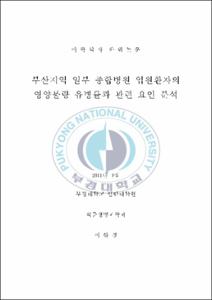부산지역 일부 종합병원 입원환자의 영양불량 유병률과 관련 요인 분석
- Abstract
- Malnutrition is associated with increased mortality, morbidity and length of hospital stay, and several studies have been reported that hospital malnutrition presents a high prevalence. The purpose of this study was to investigate the prevalence and risk factors of malnutrition in hospitalized patients in Busan, Republic of Korea. The subjects were 944(440 men and 504 women) patients in four general hospitals(over 300 beds) in Busan from March through April, 2011. In the method, nutritional status was assessed by the Nutritional Risk Screening 2002(NRS 2002) in initial hospitalization. Data were collected from the electronic medical records system for the characteristics of the subjects, clinical outcomes, biochemical laboratory data, and nutrition support states. Clinical dietitians interviewed the patients by using structured questionnaires involved in the data on weight loss and problems related oral intakes.
Malnutrition was diagnosed in 17.2% of patients. In prevalence of malnutrition between two clinical departments, internal departments had significantly(p<0.001) higher rates than those of surgical departments. Malnourished patients had significantly(p<0.001) higher ages than those of well-nourished patients, but the values of BMI, serum albumin, total cholesterol, TLC, hemoglobin, and hematocrit of malnourished patients showed significantly(p<0.001) lower than those of well-nourished patients.
According to logistic regression, the main determinant factors for nutritional status were the age(OR 1.043), length of stay(OR 1.007), BMI(OR 0.782), serum albumin(OR 0.444) and total cholesterol(OR 0.994). The malnourished patients had symptoms of anorexia(31.8%), and nausea and vomiting(18.1%), but nutritional intervention was performed only 35.8% of them. In order to increase therapeutic effects of hospitalized patients, the clinical dietitians have to offer proper nutritional intervention by the results of nutrition assessment and identification of malnutrition.
- Issued Date
- 2011
- Awarded Date
- 2011. 8
- Type
- Dissertation
- Publisher
- 부경대학교 대학원
- Department
- 대학원 식품생명과학과
- Advisor
- 남택정
- Table Of Contents
- Abstract
Ⅰ. 서론
1. 서언 1
2. 연구 목적을 위한 가설 설정 4
Ⅱ. 이론적 배경
1. 영양불량 유병률 5
2. 영양검색 도구 9
Ⅲ. 연구방법
1. 연구대상 및 방법 17
2. 연구내용 18
3. 연구기간 18
4. 자료 분석 19
Ⅳ. 연구 결과
1. 일반적 특성 20
2. 진료부서별 특성 22
가. 진료부서별 분포 22
나. 신체계측 결과 24
다. 생화학적 검사결과 26
라. 재원일수 28
3. 영양불량 유병률과 영양 상태에 따른 영양지표 비교 30
가. 영양불량 유병률 30
1) 일반적 사항에 따른 영양불량 유병률 30
2) 진료파트 및 진료부서별 영양불량 유병률 32
나. 영양 상태에 따른 NRS 2002 점수 34
1) 일반적 사항에 따른 영양상태 분포와 NRS 2002 점수 34
2) 진료파트 및 진료부서별 영양상태 분포와 NRS 2002 점수
36
다. 영양 상태에 따른 영양지표 비교 38
1) 신체계측 결과 38
2) 생화학적 검사결과 39
3) 재원일수 41
4. 영양불량에 영향을 주는 요인에 대한 분석 42
가. NRS 2002 점수와 영양지표와의 상관관계 42
나. 영양불량에 영향을 주는 요인에 대한 로지스틱 분석 44
5. 영양불량환자 특성 46
가. 식사 장애 46
나. 영양상담 의뢰 및 영양지원 여부 47
Ⅴ. 요약 및 결론 49
Ⅵ. 참고문헌 53
- Degree
- Master
- Files in This Item:
-
-
Download
 부산지역 일부 종합병원 입원환자의 영양불량 유병률과 관련 요인 분석.pdf
기타 데이터 / 2.41 MB / Adobe PDF
부산지역 일부 종합병원 입원환자의 영양불량 유병률과 관련 요인 분석.pdf
기타 데이터 / 2.41 MB / Adobe PDF
-
Items in Repository are protected by copyright, with all rights reserved, unless otherwise indicated.